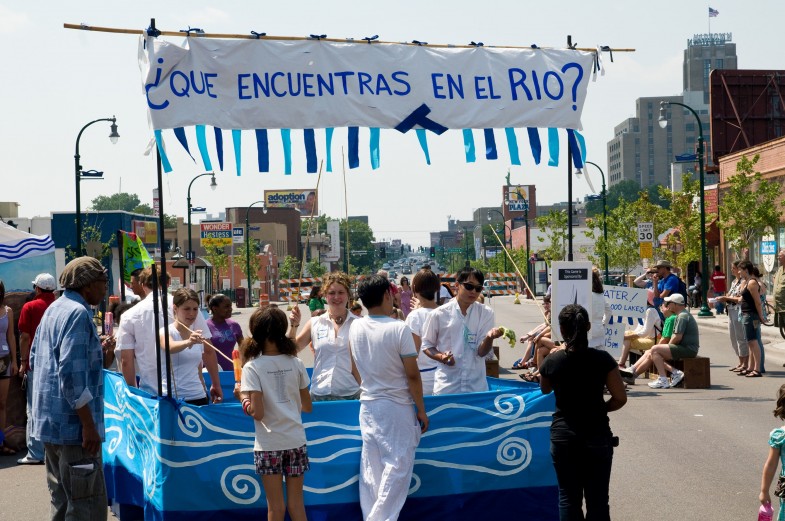p(photo-image). 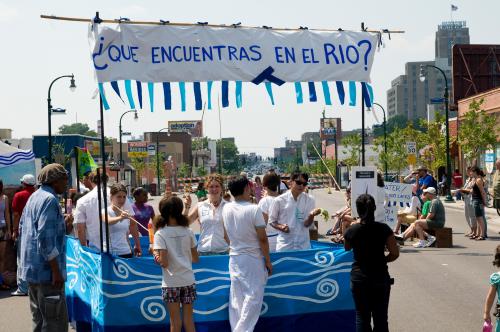
p(photo-credits). What can you find in the River? Decorate the Well in Gratitude Festival, produced by In the Heart of the Beast Puppet and Mask Theatre, photo by Bruce Silcox.
When was the last time you went to a festival celebrating a new drinking fountain? Indeed, when was the last time you even knew about a new public drinking fountain being built?
On a hot weekend in July, I had the opportunity to witness a new drinking fountain being used for the first time by dozens of thirsty people amid a joyous “water festival” organized by the In the Heart of the Beast Puppet and Mask Theatre in Minneapolis. The water festival also marked the culmination of a two-year partnership between the innovative community theater and On The Commons, which also included two engaging theater productions devoted to exploring the idea of water as a commons.
Why make such a big deal about a drinking fountain? Answering this question starts with a story. Many years ago, when In the Heart of the Beast Theatre bought the old Avalon theatre (until then a porn house) in inner city Minneapolis, the drinking fountain in the lobby did not work. Not having the money to repair the fountain, the theatre began selling bottled water at intermissions of its performances, which draw large numbers of children as well as adults.
Years later, Sandy Spieler, the theatre’s artistic director, recognized that this amounted to privatization–water was available only in plastic bottles that must be bought. Seeing water as a resource that belongs equally to all of us, she seized this as an opportunity to reclaim the commons.
p(photo-image). 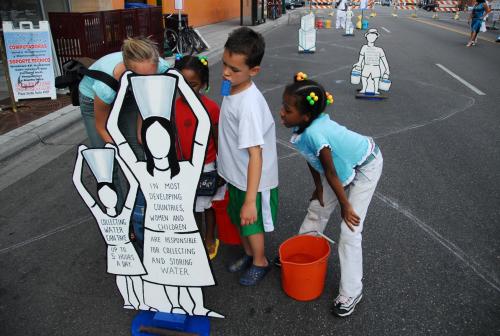
p(photo-credits). The water carrying game was educational also. Decorate the Well in Gratitude Festival, produced by In the Heart of the Beast Puppet and Mask Theatre, photo by Bruce Silcox.
Using the theatre’s situation as a microcosm of something much larger, In the Heart of the Beast working with On The Commons created a series of performances that evoked both the wonders of water and the growing concerns of local and global water issues.
The performances were illuminating experiences full of pageantry, music, humor and interactivity that engaged audiences in thinking about water on a number of levels—ecological, social spiritual, political, scientific and cultural. Powerful and at times haunting puppet figures were part of the show but also live theater that seemed a delightful mix of vaudeville, improvisation, kabuki and Ask Dr. Science. One of these performances, Beneath the Surface, will begin traveling throughout greater Minnesota in the spring of 2009.
The water festival represented the third episode of this work. Wonderfully, this festival coincides with the creation of eight public fountains across Minneapolis over the next two years, funded as a way to celebrate water in a place that proudly calls itself, “The City of Lakes.”
Two city streets in front of the theatre were closed for the festival and old-fashioned carnival games replaced the usual traffic. A fortune-teller used a deck of tarot cards with water images to instill people with the confidence that they can become heroic stewards of “Our Common Water”. A fishpond allowed young anglers to discover what can be found in the Mississippi River. Puppet shows about water quality, stewardship and the commons took place throughout the day and were enjoyed by old and young alike.
A game of musical chairs took on a new twist with a focus on shrinking aquifers. Chairs, beautifully painted like the river were removed whenever the accordionist stopped playing, and were only replaced if participants had ideas about how to protect aquifers. The traditional cakewalk became a river walk offering participants an entertaining lesson about how our lifestyle choices affect the quality of our water.
A favorite was the “Water Carry Me” game, which had everyone attempting to carry water up and down the street in pipes, in their hands, on their heads! The “Is Water Trivial?” game challenged participants to showcase their knowledge about water in many different categories. A blind taste test let folks try and tell the difference between tap water and bottled water. Local organizations working on water issues provided information about local water issues.
Inside the theatre itself people painted water flags with blue and green watercolor paints and then strung them up like prayer flags along the path leading to the beautiful, now working water fountain.
p(photo-image). 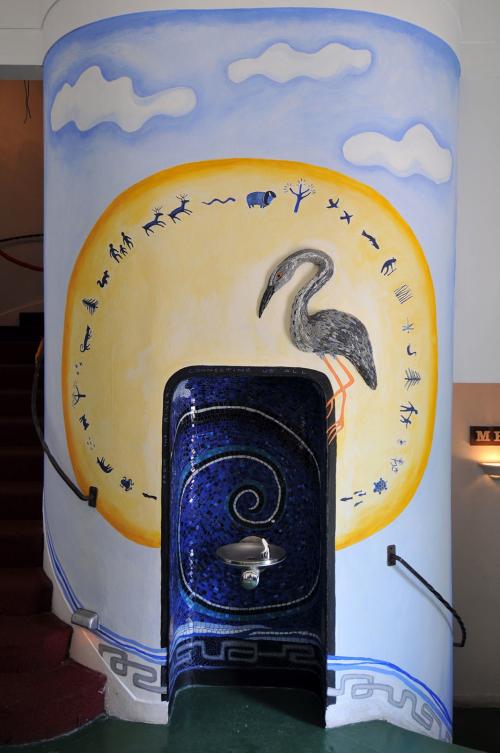
p(photo-credits). Water fountain designed by Sandy Spieler, mosaic work by Lori Greene, photo by Bruce Silcox.
During the fountain inauguration ceremony, the audience sat in a semicircle while dancers performed Aztec prayer rituals to the four directions. Poems were read, community leaders welcomed people, and then everyone was invited to take a drink, serenaded by music from a Gamelan band.
The fountain itself is stunning. Surrounded by swirls of glass mosaic tiles in shades of green and blue, it features the image of a great heron, sitting among cattails, watching over all who drink. Reaching almost to the ceiling is a painting in orange and blue with images of people, animals and water – a woman bathing, a boy fishing, an animal drinking. And under the fountain, near the floor, are grey mosaic tiles signifying the pipes that wind their way behind walls, under floors and beneath streets to carry clean, refreshing, precious water to us.
Here at On The Commons, we constantly wrestle with how to make the commons recognizable. We know the commons is all around us, but how can we make the commons more visible? How do we point to it, so all can see it?
p(photo-image). 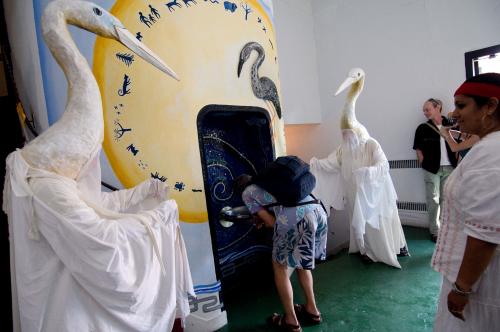
p(photo-credits). Water fountain designed by Sandy Spieler, mosaic work by Lori Greene, photo by Bruce Silcox.
One thing that can help us see the commons is a drinking fountain. A drinking fountain is a symbol of access, equality, justice, and our collective reliance on water. It stands a symbol of our realization that water is necessary for our survival, a shared need common to all living things. Just as we all need water on a daily basis – so we have a responsibility to each other and to future generations to protect water and make it accessible to all.
What better way to do that than to fix a broken public drinking fountain—to say to the whole community that we must all work together to quench our collective thirst – and protect the commons.
Rachel Breen, an artist, teacher and activist in Minneapolis, is an associate of On The Commons.




